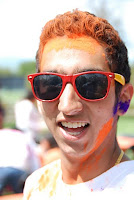 |
| Happy Holidays! |
After twenty-two years in this country, I can appreciate the holidays in a whole different light. Here are the top 10 reasons why the holidays matter to me:
1. It's an opportunity to spend quality time with one's family and friends, enjoy good food, music and chill out.
2. The holidays mean kindness. For some reason, people are a little bit nicer to each other around this time of the year. It seems as if we forget the craziness of life and just for a hot minute, we come back to the simplicity of what is truly important.
3. It's a special feeling to hear X'mas music and jingles on the radio and not Rihanna's "Diamonds in the Sky" for the 108th time.
4. There's a spirit of giving in the air that's universal. Whether it's volunteering at the soup kitchen or putting together a food drive for the homeless shelter, everyone wants to do their bit for the less fortunate.
5. It's that time of the year when the night is even darker with wind and rain drumming against the windows like a novice drum player, yet the lit-up houses and trees bring a cheer to our hearts.
6. The holidays bring out our inner child. If you have little ones you know the special joy of buying gifts for them and having them rip through them on X'mas morning. Hell, I secretly still wish I believed in Santa Claus!
7. I'm a 117-lb workout nut. But the holidays are that magical time of the year when I (and everyone else I know) doesn't mind gaining a few holiday pounds - it's worth it! And, there's always January 1st.
8. It's that time of the year when every thing's on sale. The great deal on the Chanel bag I've been waiting for, all year long...Yess!
9. It's a time for bonuses. HALLELUJAH!
 10. It's a spiritual time. For Christians, it means the birth of Jesus, for those of the Jewish faith, it can represent Hanukkah. For those of African descent, it signifies the holiday of Kwanzaa that celebrates their heritage. For Indians, the beginning of the holidays marks the occasion of Diwali or the Festival of Lights. The beauty of America is that it allows each one of us to be ourselves. And the holidays are just another time to recognize that.
10. It's a spiritual time. For Christians, it means the birth of Jesus, for those of the Jewish faith, it can represent Hanukkah. For those of African descent, it signifies the holiday of Kwanzaa that celebrates their heritage. For Indians, the beginning of the holidays marks the occasion of Diwali or the Festival of Lights. The beauty of America is that it allows each one of us to be ourselves. And the holidays are just another time to recognize that.

















